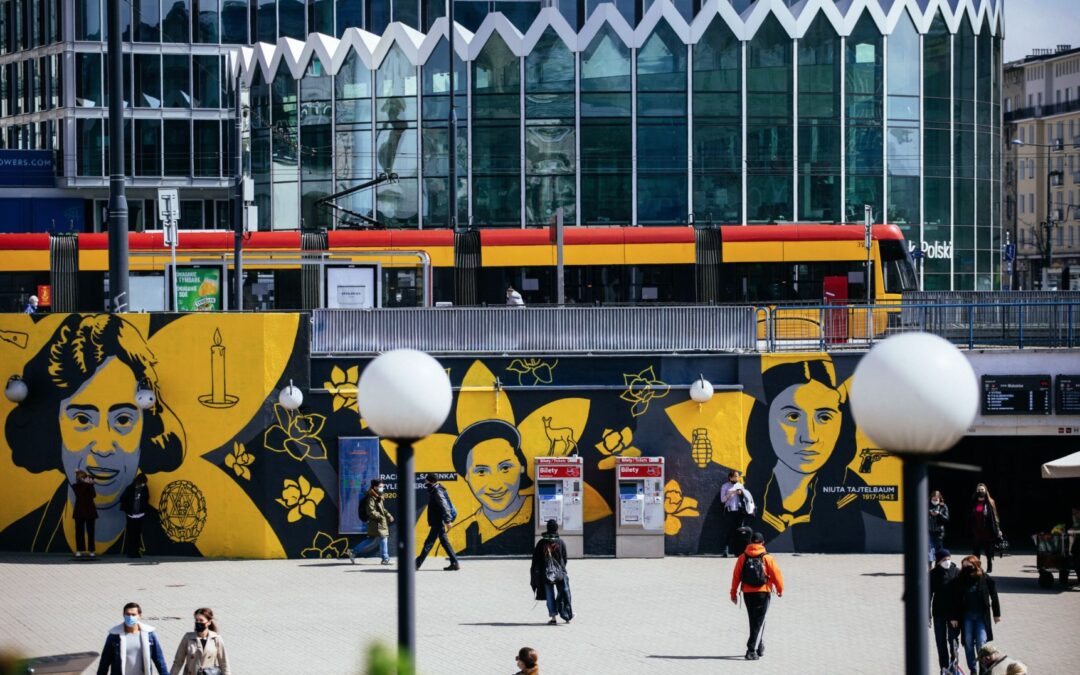Poland today marked the 78th anniversary of the Warsaw Ghetto Uprising, with a particular focus this year on the “absolutely essential” but often overlooked role played by women in what was the largest act of Jewish resistance in German-occupied Europe during the Holocaust.
A range of commemorative events took place – with President Andrzej Duda among the senior officials to participate – and sirens sounded across the city at noon. Due to the pandemic, however, attendance was limited and many events moved online.
Przy stacji metra Centrum w @warszawa okolicznościowy mural upamiętniający kobiety walczące w powstaniu w getcie warszawskim. Po raz pierwszy akcja Żonkile, która #19kwietnia, ma konkretny temat. Historie uwiecznionych kobiet na https://t.co/0laD7zEnOe. #ŁączyNasPamięć pic.twitter.com/uZwbcdRcN8
— POLIN Museum (@polinmuseum) April 18, 2021
To mark the anniversary, the POLIN Museum of the History of Polish Jews, which is located within the area of the former ghetto, unveiled a large mural outside the Centrum metro station. It features the names and images of ten women who fought in the ghetto or supported the insurgents from outside.
Among them is Niuta Tajtelbaum, who used her “youthful, innocent appearance” to gain access to German officers, a number of whom she is believed to have killed. Another, Mira Fuchrer, fought alongside Mordechai Anielewicz, leader of the Jewish Combat Organisation (ŻOB), during the uprising. Both women were killed in 1943.
According to a recent book about women’s role as resistance fighters in World War Two ghettos, around one third of those who fought in the Warsaw ghetto uprising were female.
Another to feature on the mural is Szoszana Kossower, who helped Jews escape from the ghetto and from camps, as well as organising weapons for the uprising. She survived the war and died in 2008 in Israel.
Women “undertook extremely difficult and dangerous tasks that could not be performed by men”, POLIN’s director, Zygmunt Stępiński, told Onet, which noted that they have become “forgotten heroes” of the struggle.
The museum this year also organised its annual daffodil campaign to mark the anniversary. The flowers were available at stations and on streets across the city – affixed to posters, alongside hand-gel dispensers – for the public to take and wear. Among the many public figures to join the action was foreign minister Zbigniew Rau.
Min. @RauZbigniew oraz min. SZ Izraela @Gabi_Ashkenazi, a także 🇵🇱 i 🇮🇱 dyplomaci na całym świecie upamiętnili 78. rocznicę wybuchu powstania w getcie warszawskim włączając się w #AkcjaŻonkile, organizowaną przez @polinmuseum.
➡️https://t.co/P24A2ffIOx#ŁączyNasPamięć pic.twitter.com/2cYJl4PZnV
— Ministerstwo Spraw Zagranicznych RP 🇵🇱 (@MSZ_RP) April 19, 2021
A small wreath-laying ceremony was also held at the Monument to the Ghetto Heroes opposite the POLIN museum, attended by President Duda and Michael Schudrich, the chief rabbi of Poland.
The Jewish insurgents “knew that any surrender to Nazi Germany would mean death”, said Duda at the event. “They chose to die guns in hand – they did not agree to death in concentration camps, they did not agree to death in gas chambers, they wanted to fight to the very end.”
Amid the ceremony, sirens sounded across Warsaw at noon for one minute. The city’s mayor, Rafał Trzaskowski, called on residents to “take the moment to pause, reflect and pay tribute to the insurgents. Let us show that memory connects us”.
O 12:00 w Warszawie zawyły syreny. W hołdzie Powstańcom z Getta Warszawskiego. Wielka chwała! Warszawa – miasto dwóch Powstań. Warszawa – miasto dumne ze swoich Bohaterów!
Część Ich pamięci!#ŁaczyNasPamieć pic.twitter.com/wpWTR9nxtt— Marcin Czapliński (@czaplinskiii) April 19, 2021
Elsewhere in the city, a new monument was unveiled to commemorate the Ringelblum Archive – a collection of documents from the Warsaw Ghetto buried during the war to hide it from the German Nazi occupiers and later recovered.
Other events were moved online due to the pandemic, including talks and a concert organised by POLIN. The Jewish Theatre in Warsaw broadcast a joint event with over 30 theatres across Poland, featuring interpretations of poetry about the Holocaust recorded by their actors.
The Warsaw Ghetto Uprising was the largest Jewish uprising during World War II. Though poorly armed, the insurgents, from ŻOB and the Jewish Military Union (ŻZW), fought German Nazi troops until 16 May 1943. Around 13,000 Jews died in the stuggle.
Following the uprising, the remaining 50,000 or so residents were deported to labour, concentration and death camps while what remained of the ghetto was razed to the ground. A few Jewish insurgents managed to escape through the sewers, including the last surviving leader of the uprising, Marek Edelman, who died in 2009.
Main image credit: POLIN Museum/Twitter

Juliette Bretan is a freelance journalist covering Polish and Eastern European current affairs and culture. Her work has featured on the BBC World Service, and in CityMetric, The Independent, Ozy, New Eastern Europe and Culture.pl.




















